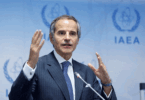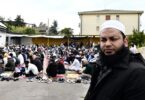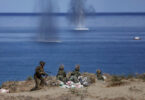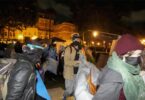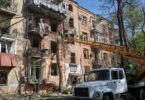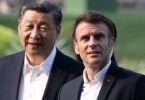WASHINGTON (thehill): A government watchdog has determined the law enforcement agencies responsible for clearing protestors gathered outside the White House last summer failed to fully warn the crowd to disperse while fractured radio communications led officers to use chemical irritants that had not been authorized.
The report from the Department of the Interior’s Office of the Inspector General (OIG) is the first to evaluate the June 1 clearing of protestors shortly before former President Trump crossed Lafayette Square for a photo-op at a nearby church with a Bible in hand.
While the event spurred accusations from lawmakers and others that the protesters were cleared to enable Trump’s passage to the church, the report ultimately determined that Trump’s plans to visit the park did not influence the officers’ decision to clear it.
The OIG found that while law enforcement learned on the day of the incident that Trump might visit, U.S. Park Police (USPP), the lead agency overseeing Lafayette Square, already planned to clear the park in order to install additional fencing around the White House.
“The evidence established that relevant USPP officials had made those decisions and had begun implementing the operational plan several hours before they knew of a potential Presidential visit to the park, which occurred later that day,” the report states.
The incident, one of several protests across the country in the wake of the May 25 death of George Floyd at the hands of a Minneapolis police officer, earned swift rebuke from those who argued the numerous officers reacted inappropriately in their use of force.
The report also paints a picture of a collection of seven law enforcement agencies that failed to act in concert, with some agencies using tear gas that had not been cleared for use and jumping in to disperse protestors before final warnings to the crowd had been given.
“Although the USPP used a sound amplifying long-range acoustic device to issue three dispersal warnings to the crowd on June 1, not everyone could hear the warnings,” the report stated.
“Multiple officers told us they either did not hear the warnings or could not clearly hear the information conveyed in the warnings. One USPP officer told us that given the size and noise level of the crowd, he believed it was unlikely that all protesters could hear the warnings.”
The miscommunications also occurred between law enforcement themselves.
Contrary to the plan, some officers began deploying before the third and final warning could be issued to protestors.
And though Park Police had instructed its officers to not use tear gas, Bureau of Prisons officers, who arrived on the scene late, did not apparently receive a full readout of which chemical agents they could use.
And the scene was further complicated by a number of other crowd-clearing agents in use.
One USPP officer told investigators that “because the USPP officers clearing H Street did not communicate over the radio when they used flash bang or stinger ball grenades, both of which emit a loud sound when used, personnel inside the park could not determine whether the noise was from munitions or fireworks set off by protesters. He speculated that the BOP may have perceived that explosions from the grenades came from the crowd instead and reacted accordingly.”
D.C.’s Metropolitan Police Department also used tear gas at the scene, even though the agency “was not a participant in or under the control of the USPP and the Secret Service’s unified command.”
The report is the first to come from several ongoing investigations. Interior’s OIG did not seek to interview Barr for the report or other White House officials, noting other investigations by watchdogs at the Department of Justice and the Government Accountability Office.
The report determined that the Park Police became aware of Trump’s visit to Lafayette Park hours before the dispersal transpired, but it did not say they altered their plans in order to accommodate his visit.
It said that officers had already planned to put up a fence and began developing plans to clear protesters before 10 a.m. on the day of the incident.
The agency’s acting chief of police said that the park police incident commander told him about President Trump’s potential visit to assess damage to the park at some point between 3 p.m. and 5 p.m. that day, while the protesters were cleared after 6 p.m.
The park police operations commander said that when he told then-Attorney General William Barr that the authorities were getting ready to move the crowd, Barr asked him, “Are these people still going to be here when POTUS [President of the United States] comes out?”
Per the report, the commander did not appear to previously know that Trump would enter the park and responded “are you freaking kidding me” then hung his head and walked away.
The official said that Barr did not order him to clear the park. This conflicts with some reporting from the time which said that the attorney general gave the order to disperse protesters, something Barr himself has denied.
The incident commander told the watchdog that he didn’t consider waiting until the Washington D.C. curfew of 7 p.m. to clear the park, saying, “We were not enforcing the Mayor’s curfew. We’re a Federal entity. We don’t work directly for the Mayor.”
The inspector general determined that it was within the Park Police’s discretion to decide when to start the operation, saying it did not find any law or rule requiring it to wait.
The report followed a request from lawmakers in both the House and Senate to “investigate whether the Park Police’s use of force in Lafayette Park complied with applicable law, regulations and agency guidance, including standards set by the Federal Law Enforcement Training Center. The OIG’s investigation should extend to actions taken by the Park Police and any other Department of Interior law enforcement agencies involved in responding to protests since the death of George Floyd. It also should examine from where the agency received its directives.”

